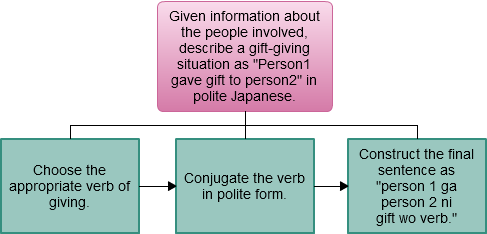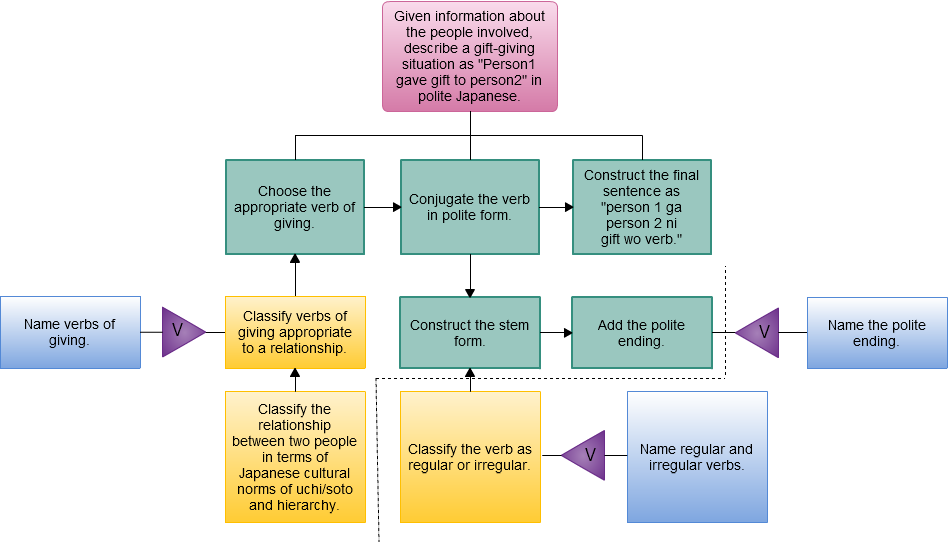SDoI: Chapter 4: Identifying Subordinate Skills and Entry Behaviors
[This is the fifth in a series of posts about Dick and Carey’s The Systematic Design of Instruction. Want to read an overview and my thoughts on Chapter 1, Chapter 2, and Chapter 3 before proceeding?]
It’s been a while (okay, more than a year) since I posted about the previous chapter, but I have not given up!
Chapter 4 is about how to further analyze an instructional goal by determining subordinate skills and entry behaviors. I found this idea interesting, so I tried it out on an example language goal: “Given information about the people involved, describe a gift-giving situation as ‘Person1 gave gift to person2’ in polite Japanese.” By information, I mean the relative ages of the people, their relationship (friends, teacher/student, parent/child, etc.), etc. Here is a simple diagram of the steps that I believe are involved.
I simplified the situation by providing a framework for the sentence where the verb and three nouns can be plugged in, rather than adding steps in which the sentence is constructed. Those steps could be added before the verb steps.
So, back to the text to learn how to analyze the subordinate skills.
On p. 54, we learn that
The hierarchical approach is used to analyze goals that are classified as intellectual or psychomotor skills.
Although this goal requires plenty of verbal information, I think that it can be usefully classified as an intellectual skill. So, I will try a hierarchical analysis.
How is hierarchical analysis done? Also on p. 54,
The hierarchical analysis technique suggested by Gagné consists of asking the question, “What must the student already know so that, with a minimal amount of instruction, this task can be learned?”
And on p. 58,
One way to proceed is to ask, “What mistake might students make if they were learning this particular subordinate skill?”
Further information is provided on pp. 58-59.
You should also ask the following questions:
- Have I included subskills that relate to the identification of basic concepts, such as objects or object qualities? (Example: Can a tetrahedron be identified?)
- Have I included subskills that enable students to identify abstractions by means of a definition? (Example: Can the student explain what a city is, or show what an emulsion is?)
- Have I included subskills that will enable students to apply rules? (Example: Making sentence verbs agree with subjects, simplifying mixed fractions.)
- Have I included subskills in the analysis that will enable students to learn how to solve problems required to demonstrate mastery of the instructional goal?
I tried to incorporate these questions into my subordinate analysis, and I used the information on creating instructional analysis diagrams on pp. 62-64 to construct the following:
Just for visual clarity, I made steps green, subskills yellow, and verbal information blue. One problem that I had with making the diagram was that my third step (“Construct the final sentence…”) requires verbal information, such as knowing the Japanese words for various pronouns and other nouns that represent the gift. But none of the examples in the book show verbal information being connected directly to a step. It is always connected to a subskill, so I am not sure if it is okay to add it to a step.
The subskills could be taken further, but I think that I have already defined some that I consider entry behaviors. In the glossary (p. 346), “entry behaviors” are defined as
Specific competencies or skills a learner must have mastered before entering a given instructional activity.
I would designate the entry behaviors for this goal as everything below and to the right of the dotted line. In other words, students should already know some regular and irregular verbs and the polite ending before learning this goal.
So, that is my attempt to apply this chapter to a very specific language goal.
One other comment on this chapter: One of the examples of a cluster analysis struck me as a terrible way to organize information. While hierarchical analysis is used for intellectual goals, cluster analysis is used for verbal information. The glossary (p. 345) defines “cluster analysis” as
A technique used with goals in the verbal information domain to identify the specific information needed to achieve the goal and the ways that information can best be organized or grouped.
So, why in the world would you organize anatomy vocabulary as lists of words, as the books shows on p. 87? Wouldn’t the best, most intuitive way to organize it be as labels on a drawing of a body?


